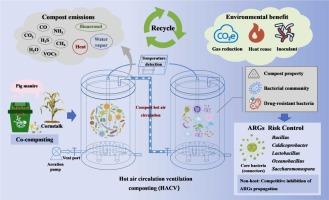热风循环通风堆肥系统通过核心细菌的竞争性抑制去除抗生素抗性基因
IF 11.3
1区 环境科学与生态学
Q1 ENGINEERING, ENVIRONMENTAL
引用次数: 0
摘要
畜禽粪便是抗生素抗性基因(ARGs)的重要储存库。好氧堆肥技术可以在有效去除ARGs的同时产生成熟的堆肥。在本研究中,我们开发了一种节能减排的热风循环通风堆肥技术(HACV),该技术对堆肥过程和堆肥成熟度没有不利影响。HACV堆肥改变了细菌群落,主要是由确定性因素之间的异质选择驱动的(65%)。具体来说,它增加了细菌网络的复杂性,促进了耐高温细菌的定植,如丹毒杆菌、海洋杆菌和unclassified_f_Bacillaceae。拓扑分析表明,核心菌在堆肥过程中主要扮演着连接者的角色,是重要的ARGs宿主,并促进其在常规堆肥中的传播。其中,核心致病菌(棒状杆菌)携带和传播ARGs的风险较高。相比之下,尽管在HACV堆肥过程中核心细菌(Bacillus, Oceanobacillus, Caldicoprobacter, Saccharomonospora和Lactobacillus)的数量增加,但这些细菌不是目标ARGs的潜在宿主。对aadE的去除率为80.49%。因此,与传统堆肥相比,HACV堆肥在控制高风险ARGs方面更有效,特别是aac(6′)-Ib-cr和sul1。此外,ARGs的去除机制主要涉及抑制HACV堆肥中的水平基因转移(HGT),这归因于核心细菌与ARGs宿主之间的竞争。综上所述,HACV堆肥有效地促进了ARGs的去除,降低了细菌耐药性的风险。在本研究中,我们开发了一种节能减排的热风循环通风堆肥技术(HACV),可以有效地去除抗生素抗性基因(ARGs)。HACV系统在保持堆肥效率和成熟度的同时,通过确定性过程(同质选择)驱动细菌群落演替。HACV堆肥增加了微生物网络中核心细菌的定植。核心菌在HACV系统中作为连接器,不是ARGs的宿主,通过与宿主菌的竞争抑制水平基因转移(HGT),清除ARGs。本文章由计算机程序翻译,如有差异,请以英文原文为准。

The hot air circulation ventilation composting system removes antibiotic resistance genes through competitive inhibition by core bacteria
Livestock manure is a significant reservoir of antibiotic resistance genes (ARGs). Aerobic composting technology can produce mature compost while effectively removing ARGs. In this study, we developed an energy-saving and emission-reducing hot air circulating ventilated composting technology (HACV), which had no adverse effects on the composting process or compost maturity. The HACV composting altered bacterial communities, primarily driven by heterogeneous selection among deterministic factors (65 %). Specifically, it increased the complexity of bacterial networks and promoted the colonization of high-temperature-tolerant bacteria, such as Erysipelothrix, Oceanobacillus and unclassified_f_Bacillaceae. Topological analysis revealed that core bacteria primarily functioned as connectors in composting, serving as important ARGs hosts and facilitating their spread in conventional composting. Among these, a core pathogenic bacterium (Corynebacterium) carried and transmitted ARGs with higher risks. In contrast, although the number of core bacteria (Bacillus, Oceanobacillus, Caldicoprobacter, Saccharomonospora, and Lactobacillus) increased during HACV composting, these bacteria were not potential hosts of the target ARGs. This contributed to the removal of aadE by 80.49 %. Consequently, compared to conventional composting, HACV composting was more effective at controlling risky ARGs, particularly aac(6′)-Ib-cr and sul1. Furthermore, the ARGs removal mechanism primarily involved inhibiting horizontal gene transfer (HGT) in HACV composting, attributed to competition between core bacteria and ARGs hosts. In summary, HACV composting effectively promotes ARGs removal and reduces the risk of bacterial resistance.
Environmental Implication
In this study, we developed an energy-saving and emission-reducing hot air circulation ventilation composting technology (HACV), which effectively removes antibiotic resistance genes (ARGs). The HACV system maintained composting efficiency and maturity while driving bacterial community succession through deterministic processes (heterogeneous selection). HACV composting increased the colonization of core bacteria in the microbial network. Acting as connectors, the core bacteria are not hosts of ARGs in the HACV system, inhibiting horizontal gene transfer (HGT) and remove ARGs through competition with host bacteria.
求助全文
通过发布文献求助,成功后即可免费获取论文全文。
去求助
来源期刊

Journal of Hazardous Materials
工程技术-工程:环境
CiteScore
25.40
自引率
5.90%
发文量
3059
审稿时长
58 days
期刊介绍:
The Journal of Hazardous Materials serves as a global platform for promoting cutting-edge research in the field of Environmental Science and Engineering. Our publication features a wide range of articles, including full-length research papers, review articles, and perspectives, with the aim of enhancing our understanding of the dangers and risks associated with various materials concerning public health and the environment. It is important to note that the term "environmental contaminants" refers specifically to substances that pose hazardous effects through contamination, while excluding those that do not have such impacts on the environment or human health. Moreover, we emphasize the distinction between wastes and hazardous materials in order to provide further clarity on the scope of the journal. We have a keen interest in exploring specific compounds and microbial agents that have adverse effects on the environment.
 求助内容:
求助内容: 应助结果提醒方式:
应助结果提醒方式:


